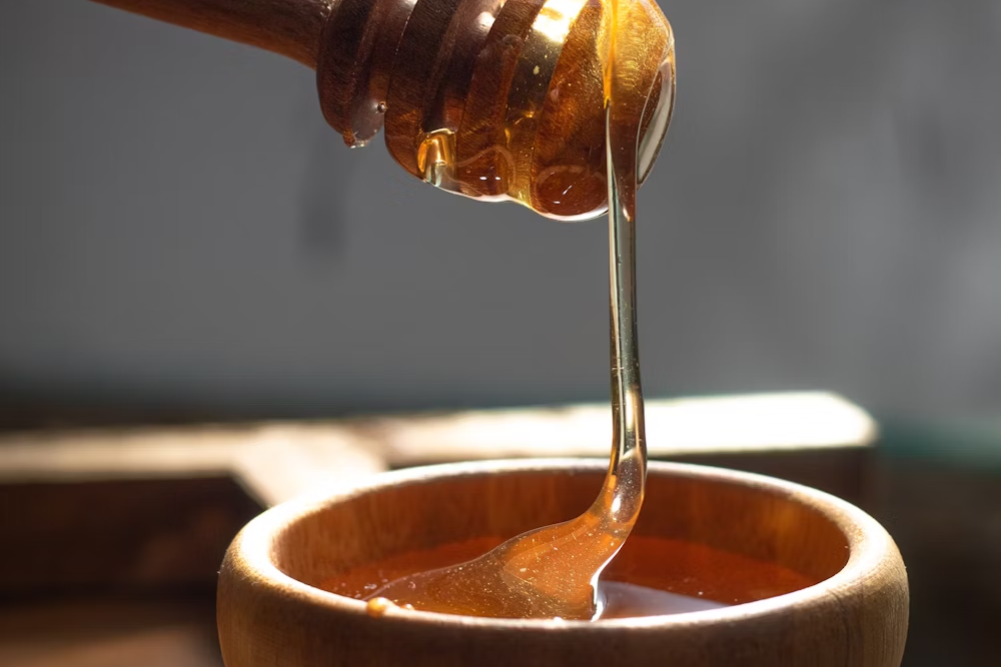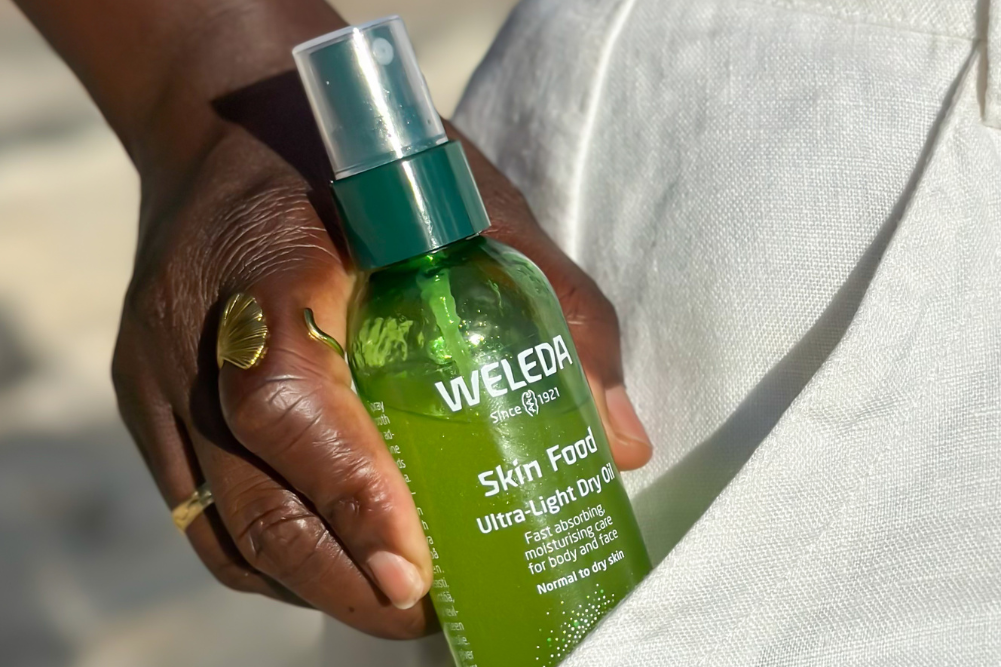Discover the health and beauty benefits of Moroccan Blue Tansy
Beauty trends come and go. What is deemed the hottest ingredient one moment is soon surpassed by another that’s said to be even better. However, the latest star of the skincare industry, blue tansy (Tanacetum annuum), looks set to become a mainstay due to its ability to calm inflamed skin — and emotions.
For the skin, its anti-microbial, anti-fungal and anti-allergenic properties are making it a go-to for those suffering from inflamed conditions such as eczema, dermatitis and psoriasis. For the emotions, blue tansy is, in fact, from the chamomile family (think Roman and German chamomile), so you can expect it to be calming; yet its sweet smell is also uplifting.
Blue tansy’s deep, complex herbaceous floral aroma instantly calms and soothes the nervous system, working double-duty for the skin while also helping to calm the emotions.
Sometimes called “Moroccan chamomile” or “Moroccan tansy”, the essential oil extracted from it is at the centre of all the fuss. The steam distillation process, which extracts the revered oil from the plant’s leaves, yellow flowers and stems, produces a rich, cobalt blue.
That deep blue hue
While chamazulene is an aromatic chemical compound that gives all chamomile oils their colours, the plant itself doesn’t contain it — it’s only formed through the steam distillation process, which is why the blue tansy plant isn’t actually blue. A sesquiterpene compound called matricin, found naturally in the aerial parts of chamomile plants, goes through a reaction when it’s in the presence of water vapour at high temperatures. The “reaction product” is chamazulene, resulting in the deep blue hue.
Of all the chamomile essential oils, blue tansy boasts the most chamazulene, which, besides its colour, also gives the oil its touted skin-soothing properties. “However, remember that with great power comes responsibility,” says doTERRA essential oils managing scientist, Nicole Stevens. “There is so much chamazulene in blue tansy that the oil can actually stain skin and surfaces blue, so it must be used carefully.”
Natural skincare formulator and celebrity favourite Josh Rosebrook agrees. “Blue tansy is an incredible, therapeutic, skin-benefitting ingredient. It’s very healing for the skin in specific concentrations in a formula. Restraint by the formulator must be used,” he says. “Moroccan chamomile has a potent anti-inflammatory benefit that assists clearing eczema and psoriasis conditions, which are essentially inflammation. The aromatheraputic benefits are extremely healing.”
Rosebrook, who uses the oil in his products, says blue tansy’s deep, complex herbaceous floral aroma instantly calms and soothes the nervous system, working double-duty for the skin while also helping to calm the emotions.
An essential oil trend
In a quest to discover the next big anti-ageing and beautyifying ingredient, it’s not surprising the attention has turned to yet another contender. However, according to Kindred Toxin Free Facials’ senior therapist and owner, Natalie Sellars, blue tansy’s time in the spotlight is also due to growing interest in the natural beauty industry — and because consumers are looking for something “unique” they haven’t seen before.
“Ingredients like blue tansy are starting to be recognised as powerful, natural alternatives in products,” she says. “It has amazing soothing properties for inflamed skin conditions like dermatitis, but also as our skin becomes more prone to environmental stressors, this ingredient is a great one for helping support our skin daily.” For those who regularly suffer from blemishes and breakouts, it’s an oil to have at arm’s reach. The chamazulene’s anti-inflammatory and calming abilities are excellent for acne-prone or sensitive skin.
Ancient beginnings
While Morocco claims blue tansy as its own, it’s widely believed the ancient Greeks were the first to discover the many medicinal benefits of the plant. Meanwhile, Benedictine monks relied on it to expel intestinal worms. They also used it for fevers, digestive upsets, rheumatism and even to support the body through a measles outbreak. It has also been used to treat gout.
In his 1964 book Poisonous Plants of the United States and Canada, John Merriam Kingsbury described how tansy was used in high doses to abort foetuses, yet it’s also documented as an aid for those wanting to conceive and prevent miscarriages, according to Richard LeStrange’s A History of Herbal Plants.
The Cherokee Indians used an infusion of the plant to treat backaches and tied it around their waist and placed it in their shoes to prevent miscarriages. It was also used to treat dizziness and weakness.
Know what you’re looking for
While our ancestors did take tansy internally, there’s good reason to apply caution if you plan to follow suit. If taken internally, it has been found that toxic metabolites are produced as the oil is broken down in the liver and digestive tract.
With various species in the tansy family, it’s important to know exactly what you’re looking for if you’re keen to bring blue tansy into your beauty routine, especially if you decided to buy the oil instead of formulated products that contain it.
Many tansies contain a volatile oil, and, if you’re sensitive, topical use could result in contact dermatitis. Blue tansy, or Tanacetum annuum, is often confused with common tansy (Tanacetum vulgare), which contains thujone — best known as a chemical compound found in the spirit, absinthe. However, it does not include blue tansy’s skin-soothing chamazulene.
Some less-than-ethical essential oil wholesalers have been known to adulterate the highly priced blue tansy with the much cheaper common tansy. However, it’s important to note that the latter does not have the signature deep blue hue.
In his Essential Oil Safety textbook, Robert Tisserand warns against internal use. “Toxic signs produced by tansy oil poisoning include convulsions, irregular heartbeat, vomiting, rigid pupils, gastroenteritis, uterine bleeding, flushing, hepatitis, cramps, loss of consciousness and rapid breathing (Grieve 1978),” he writes.
Blue Tansy essential oil use can also result in possible skin sensitivity. Always keep out of the reach of children. If you are pregnant, consult a qualified physician before using. Avoid contact with the eyes, inner ears and sensitive areas. It may also stain surfaces, fabrics and skin.
A multi-purpose oil
While blue tansy is undoubtedly a beauty must-have, it really is a multi-purpose oil says aromatherapist, health educator and founder of essential oil company Twenty8, Kim Morrison. The author of the bestselling aromatherapy book Like Chocolate for Women says it’s also one to keep in the medicine cabinet during allergy season, as it can help to neutralise histamine production.
For those who regularly suffer from blemishes and breakouts, it’s an oil to have at arm’s reach. The chamazulene’s anti-inflammatory and calming properties are excellent for acne-prone or sensitive skin.
“It is one of the best oils to use in a foot bath for fungal infections like athlete’s foot,” Morrison says. “It also has analgesic qualities and in a massage blend would make an excellent pain reliever for sciatica, backache, nerve inflammation and muscle spasms.”
Used alongside healing oils like eucalyptus, pine and tea-tree, it can also help relieve many respiratory conditions such as coughs, colds, flu and asthma, she adds. “Especially when used in a diffuser or in a good old-fashioned inhalation with the towel over the head. Just remember, like all essential oils, blue tansy should not be ingested or applied undiluted without advanced essential oil education or under the guise of a qualified aromatherapy practitioner.”
For the skin, Morrison recommends adding a “drop or two” of blue tansy to your favourite natural skincare product, or simply to a cold-pressed carrier oil such as coconut to help soothe and clear congested skin. “It has an incredible ability to reduce redness, itchiness and swelling with skin conditions like eczema and dermatitis,” she says.
Mind, body, spirit
Just as the oil fosters skin healing, it also supports you emotionally and spiritually, says Jocelyn Oades, founder, healer and skincare expert at New Zealand eco sanctuary, Earth Spa.
Known by some as the “oil of inspired action”, it’s an “enticing oil” that supports your desire to be responsible for your full potential, says Oades. “It acts as a catalyst when you need to make changes, and helps you follow through,” she says. “Because of its sweet, soft aroma, like the other chamomile oils it’s also relaxing and supports your body’s systems for emotional stability.
“I love to use blue tansy on my lower back, or any area to soothe aches,” she adds. “Placing a drop on my hand and pressing on my neck and décolletage is a refreshing way to calm and regulate breathing, while feeling my passion for life. Because of the inspired action and motivation effect of this oil, I also love to rub it over my solar plexus.”
Blue tansy and Chinese medicine
Known in Traditional Chinese Medicine (TCM) as a qi regulator, blue tansy is one of the best oils for treating conditions of general qi — the circulating life force at the basis of Chinese philosophy and medicine — constraint, says TCM practitioner, aromatherapist and educator, Peter Holmes.
“[In this context the] body and mind are tense, reactive, irritable and tend to heat and immediately respond to stress in an injurious way. The result is systemic qi stagnation and constraint,” Holmes says. “Typical symptoms that can arise in this type of individual can be tension, pain, heat and hypersensitivity.”
Allergies with acute inflammation, which in TCM are known as classic modern wind-heat conditions, stem from constrained qi. “No other oil comes close to blue tansy’s ability to address them,” Holmes says. “In atopic asthma from stress, where the liver qi invades the lung, causing it to accumulate instead of descend, blue tansy is excellent. Even without the support of other lung-qi descending oils such as hyssop and thyme.”
He also says it can be used to treat unexplained psychosomatic aches and pains, as well as rheumatic or neuralgic pain. For hay fever, sinusitis and middle ear inflammations, Holmes recommends using blue tansy in steam inhalations, along with lavender essential oil. “Headaches and sciatica will be relieved with it. Blue tansy is one of the best oils for depression with anxiety, or agitated forms of depression.”
Choosing your blue tansy
While essential oil companies worldwide may market their blue tansy as the best to buy, it’s imperative to know whether the supplier is reputable and trusted, Sellars says. “I only use blue tansy products from aromatherapists and skincare chemists I trust. These practitioners have the skills to ascertain the quality of the oils and only work with the highest grade and quality … similarly, do your research: there are several resources online that can help you find information on reputable blue tansy suppliers.”
Oades also says it’s vital that blue tansy is sourced in its natural Moroccan environment. “It is harvested here to produce the highest-quality oil in its purest form. The importance of having the Certified Pure Therapeutic Grade certification is that the oil is grown, harvested and distilled with the indigenous people who know the growing cycle and conditions needed for the oil to be pure and unadulterated,” she says.
Dilution
Blue tansy essential oil should not be used neat and should always be diluted with a carrier oil, advises Sellars. Dilution increases the amount of skin on which the oil is applied and absorbed, adds Stevens. “It also enhances absorption through dry skin and minimises possible sensitivities. It is never wrong to dilute oils, especially when using oils with a more potent chemistry,” Stevens adds. She says a good place to start when diluting oils is with a range of one drop of essential oil to between one and five drops of carrier oil.
Contraindications
“If you are pregnant, you should always check with your doctor before using any products containing blue tansy. It can sometimes interfere with medications like antibiotics, antidepressants or antihistamines, so check with your GP,” Sellars says.








